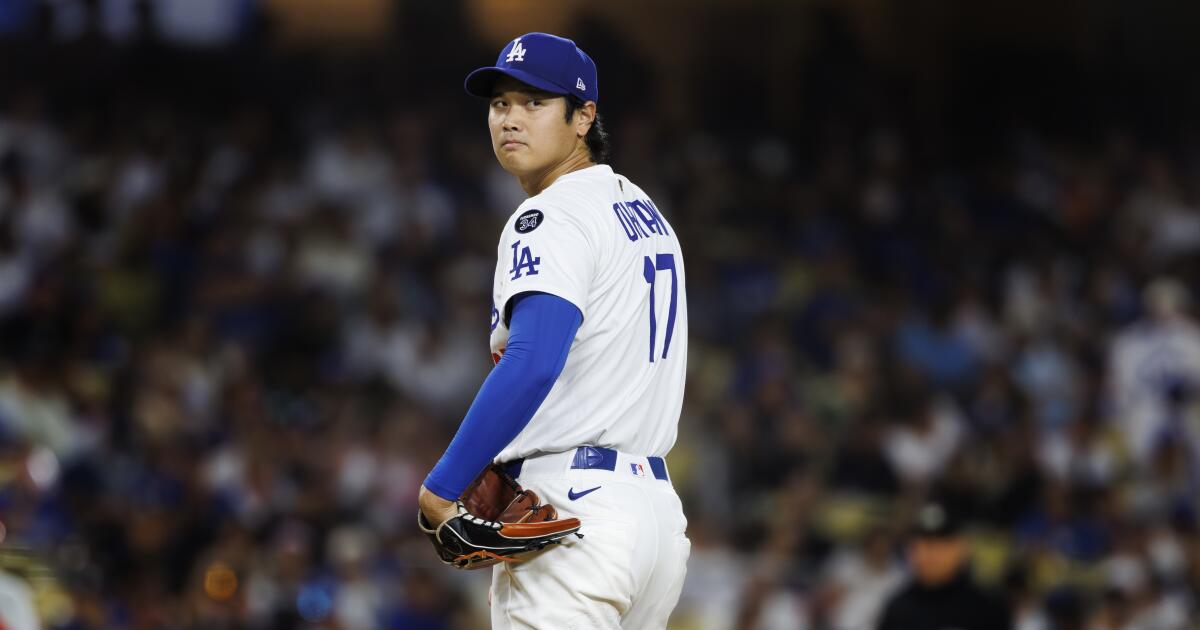Shohei Ohtani’s unprecedented night leads Dodgers back to World Series
Two days ago, Shohei Ohtani rolled into Dodger Stadium as a man on a mission.
After struggling for the previous couple weeks — mired in a postseason slump that had raised questions about everything from his out-of-sync swing mechanics to the physical toll of his two-way duties — the soon-to-be four-time MVP decided it was time to change something up.
Over the previous seven games, going back to the start of the National League Division Series, the $700-million man had looked nothing like himself. Ohtani had two hits in 25 at-bats. He’d recorded 12 strikeouts and plenty more puzzling swing decisions. And he seemed, in the estimation of some around the team, unusually perturbed as public criticisms of his play started to mount.
So, during the team’s off-day workout Wednesday at Dodger Stadium, ahead of Game 3 of the NL Championship Series, Ohtani informed the club’s hitting coaches he wanted to take batting practice on the field.
It was a change from his normal routine — and signaled his growing urgency to get back on track.
“If this was a regular-season situation and you’re looking at an expanse of small sample — eight, nine games, whatever it might be — he probably wouldn’t be out on the field,” manager Dave Roberts said later.
But “with the urgency [of] the postseason,” the manager continued, Ohtani “wanted to make an adjustment on his own.”
Whatever Ohtani found that day, evidently (and resoundingly) clicked. He led off Game 3 with a triple. He entered Game 4 looking more comfortable with his swing. And then, in one of the incredible individual displays ever witnessed in playoff history, he lifted the Dodgers straight into the World Series.
In a 5-1 defeat of the Milwaukee Brewers that completed an NLCS sweep and gave the Dodgers their 26th pennant in franchise history, Ohtani hit three home runs as a hitter, and struck out 10 batters over six-plus scoreless innings as a pitcher.
Shohei Ohtani pitches during Game 4 of the NLCS against the Brewers. Ohtani struck out 10 over six scoreless innings for the Dodgers.
(Gina Ferazzi / Los Angeles Times)
He made his previously disappointing playoffs a suddenly forgotten memory, earning NLCS MVP honors and to the astonished amazement of all 52,883 in attendance.
And he delivered the kind of game the baseball world dreamed about when the two-way phenom first arrived from Japan, fulfilling the prophecy that accompanied him as a near-mythical prospect eight years earlier.
Back then, Ohtani’s 100-mph fastball and wicked off-speed repertoire had tantalized evaluators. His majestic left-handed swing had tortured pitchers in his home country.
Not since Babe Ruth had the sport seen anything like him.
There were some early growing pains (and injuries) during his transition to the majors. But over the last five years, he blossomed in the game’s definitive face.

A look at the three home runs Shohei Ohtani hit in Game 4 of the NLCS on Friday.
All that had been missing, in a resume chock full of MVPs and All-Star selections and unthinkable records even “The Great Bambino” never produced, was a signature performance in October. A game in which he dominated on the mound, thrilled at the plate, and single-handedly transformed a game on the sport’s biggest stage.
During that Wednesday workout this week, Ohtani got himself ready for one, stepping into the cage during his on-field batting practice — as his walk-up song played through the stadium speakers and teammates gathered near the dugout in curious anticipation — and swatting one home run after another, including one that soared to the roof of the right-field pavilion.
On Friday, in an almost unimaginable showcase of his unprecedented talents, he managed to do exactly the same thing.
After stranding a leadoff walk in the top of the first with three-straight strikeouts, Ohtani switched from pitcher to hitter and unleashed a hellacious swing. Brewers starter José Quintana left him an inside slurve. Ohtani turned it into the first leadoff home run ever by a pitcher (in the regular season or playoffs). The ball traveled 446 feet. It landed high up the right-field stands.

Three more scoreless innings of pitching work later, Ohtani came back to the plate and hit his second home run of the night even farther. In a swing almost identical to his titanic BP drive two days prior, he launched a ball that darn near clipped the pavilion roof again, a 469-foot moonshot that landed in the concourse above the seats in right.
Somehow, there was still plenty more to come.
With the Dodgers up 4-0 at that point, Ohtani then did his best work as a pitcher, following up two strikeouts that stranded a leadoff double in the fourth — and had him excitedly fist-pumping off the mound — with two more in both the fifth and the sixth.
His fastball was humming up to triple-digits. His sweeper and cutter were keeping the Brewers off balance. His splitter wasn’t touched once any of the five times they tried to swing at it.
Shohei Ohtani runs the bases after hitting his third home run of the game against the Brewers in Game 4 of the NLCS at Dodger Stadium on Friday night.
(Gina Ferazzi/Los Angeles Times)
Anything he did immediately became magic.
Ohtani’s loudest roar came in the bottom of the seventh, after his pitching start had ended on a walk and a single led off the top half of the inning.
For the third time, he flung his bat at a pitch over the plate. He sent a fly ball sailing deep in a mild autumn night. He rounded the bases as landed beyond the center field fence.
Three home runs. Six immaculate innings. A tour de force that sent the Dodgers to the World Series.
All of it, just two days removed from Ohtani being seemingly at his lowest.
All of it, when the baseball world was most closely watching.
Dodgers players and coaches celebrate after sweeping the Milwaukee Brewers in the NLCS at Dodger Stadium on Friday night.
(Robert Gauthier / Los Angeles Times)



